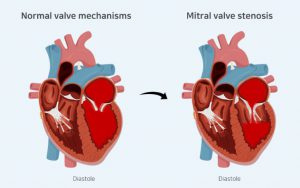
Nội dung bài viết / Table of Contents
This post is also available in: Tiếng Việt (Vietnamese)

The mitral valve is a valve located on the left side of your heart, between two chambers, the atrium (upper) and the ventricle (lower). Blood is pumped from the left atrium, through the mitral valve, and into the left ventricle on its way to the aorta.
The healthy mitral valve allows blood to pass through, but prevents it from flowing back. Mitral valve stenosis, also known as mitral stenosis, is disease when the mitral valve opening is narrowed.
This means that not enough blood can flow through it. This can lead to a variety of issues, including fatigue, difficulty breathing, blood clots, and heart failure. Scarring caused by rheumatic fever is the leading cause of mitral valve stenosis. Rheumatic fever is common in some countries.
Two thirds of all patients with mitral stenosis are female. The onset of symptoms usually occurs between the third and fourth decade of life. Please discuss with your doctor for further information.
The common symptoms of mitral stenosis are:
Mitral valve stenosis symptoms may appear or worsen anytime your heart rate increases, such as during exercise. An episode of rapid heartbeats may accompany these symptoms. Or they may be triggered by pregnancy or other body stress, such as an infection.
Mitral valve stenosis may also produce signs that your doctor will find during your examination. These may include:
If you have any signs or symptoms listed above or have any questions, please consulting with your doctor. Everyone’s body acts differently. It is always best to discuss with your doctor what is best for your situation.
There are three main causes of mitral valve stenosis, include:
Rheumatic fever
A complication of strep throat, rheumatic fever can damage the mitral valve. Rheumatic fever is the most common cause of mitral valve stenosis. It can damage the mitral valve by causing the flaps to thicken or fuse. Signs and symptoms of mitral valve stenosis might not show up for years.
Calcium deposits
As you age, calcium deposits can build up around the ring around the mitral valve (annulus), which can occasionally cause mitral valve stenosis.
Other causes
In rare cases, babies are born with a narrowed mitral valve (congenital defect) that causes problems over time. Surgery is usually recommended to repair congenital mitral stenosis. Other rare causes include radiation to the chest and some autoimmune diseases, such as lupus.
There are many risk factors for mitral stenosis, such as:
The information provided is not a substitute for any medical advice. ALWAYS consult with your doctor for more information.
If your doctor suspects that you may experience this condition, a physical examination will be performed and some tests will be also recommended by your doctor. Some common tests may include:
Transthoracic echocardiogram
Sound waves directed at your heart from a wand-like device (transducer) held on your chest produce video images of your heart in motion. This test is used to confirm the diagnosis of mitral stenosis.
Electrocardiogram (ECG)
Wires (electrodes) attached to pads on your skin measure electrical impulses from your heart, providing information about your heart rhythm. You might walk on a treadmill or pedal a stationary bike during an ECG to see how your heart responds to exertion.
Chest X-ray
This enables your doctor to determine whether any chamber of the heart is enlarged and the condition of your lungs.
Transesophageal echocardiogram
A small transducer attached to the end of a tube inserted down your esophagus allows a closer look at the mitral valve than a regular echocardiogram does.
Cardiac catheterization
This invasive technique isn’t performed routinely for mitral stenosis, but it might be used when more information is needed to assess your condition.
After diagnosing your condition, the doctor will recommend you some treatment options, include:
Drugs and Medication
If your mitral valve stenosis is causing symptoms, your doctor might prescribe medications. Although these do not actually fix the problem with your mitral valve, they can help treat your symptoms.
Valvuloplasty
Your doctor may choose to perform a mitral balloon valvuloplasty. If you need more treatment than just medication, but your mitral valve is not damaged enough to require heart surgery, this procedure is an option.
Surgery
Surgery may become necessary. Your doctor might be able to surgically repair your existing mitral valve to make it function properly. If that isn’t possible, you may need to have your mitral valve replaced with a new one.
Read more: Mitral regurgitation – Symptoms and causes
What are some lifestyle changes or home remedies that can help me manage mitral stenosis?
The best way to prevent mitral valve stenosis is to prevent its most common cause, rheumatic fever. You can do this by making sure you and your children see your doctor for sore throats. Untreated strep throat infections can develop into rheumatic fever. Fortunately, strep throat is usually easily treated with antibiotics.
If you have any questions, please consult with your doctor to better understand the best solution for you.
Sources: